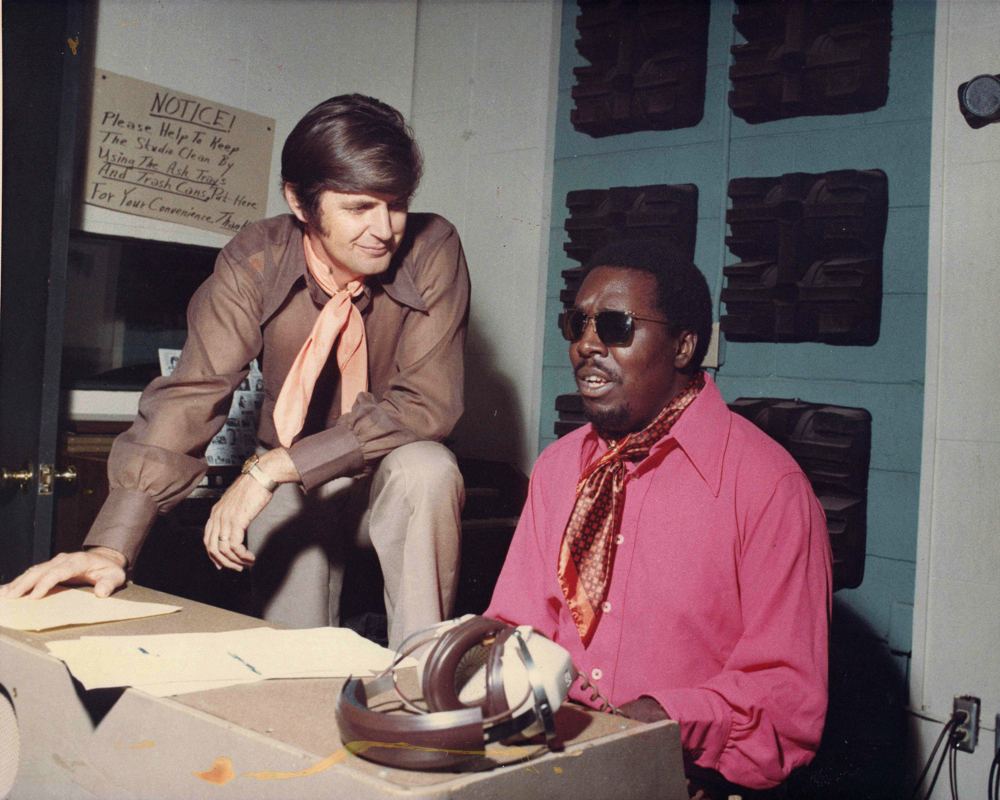Greg Camalier’s Musical Muscle
The town of Muscle Shoals, situated off the Tennessee River in a less-traveled pocket of Alabama, might seem like an unlikely place for rock stars to casually drop in. But over the past decades, it’s served as a fertile crescent and almost mythic place for some of the most iconic American musical acts.
Rick Hall, a local who emerged out of extreme poverty and familial tragedy to refashion himself as music producer, convinced local bellhop-turned-soul pioneer Arthur Alexander to record his first hit “You Better Move On” in an abandoned tobacco warehouse in 1961. With that, Hall founded FAME Studios, a no-frills establishment that would play host to a number of artists who would come to embody the “Muscles Shoals” style of R&B—Wilson Pickett, Percy Sledge, Clarence Carter, Aretha Franklin, and more—all backed up by The Swampers, the house rhythm section who eventually formed the studio Muscle Shoals Sound. Hall’s charisma and tenacity, including uniting black and white in volatile Alabama during the Civil Rights Era, gave rise to music that would soon lure Bob Dylan, The Rolling Stones, Etta James, Paul Simon, and The Black Keys down to Muscle Shoals to record.
Greg “Freddy” Camalier, a first-time filmmaker and amateur musician, traveled through Muscle Shoals while on a cross-country road trip and funneled his interest in the town and its musical history into the documentary Muscle Shoals. Camalier and his crew decamped to Alabama to meet with Hall and The Swampers before recruiting Mick Jagger, Keith Richards, Bono, and Aretha Franklin, among others, to appear on camera and discuss the studios’ legacy.
Cut with 8mm archival footage culled from FAME Studios’ archive, 16mm film sourced from a Swedish documentary crew, and snippets from Albert and David Maysles’ 1970 Stones documentary Gimme Shelter, Camalier crafts and in-depth account of a previously unarticulated story.
Interview recently caught up with Camalier in New York.
COLLEEN KELSEY: It’s your first time directing. I know you worked in real estate before. How did you make the jump to filmmaker and get involved with telling this story?
GREG “FREDDY” CAMALIER: This story just kind of found us. I was not looking to make a documentary at all. I was just helping my buddy move, driving a car across the country because he was moving to New Mexico and he needed help driving his car like 1,700 miles. We just ended up in Muscle Shoals late one night. We knew some music that we loved was made there, so we went there, but we had no idea the magnitude of the story. We were immediately impacted by the town, and we ended up not leaving the next morning but just staying all day and through the afternoon and were researching it, calling the studios and reading about it online and being like “Holy cow!,” you know?
We just sort of jived with the town, and then the story seemed incredible. That next day was the genesis for the film where we were like, “I can’t believe this story hasn’t been told. We should tell it.” I was really missing the creative aspect of my life. I had been an amateur musician, but I always wanted to be a professional musician. It was just never really going to happen, and it didn’t happen. I was just doing real estate and really missing the creative outlet in my life. It had just been dormant for years. I knew in the back of my mind I wanted to give filmmaking a shot, but I was thinking narrative. I was never thinking documentary. It was kind of by default. I even tried to get out of directing this movie, [laughs] and I’m so glad I didn’t, because it turned out to be an amazing journey.
KELSEY: Why do you think the town of Muscle Shoals is so special? Can you describe it?
CAMALIER: It definitely seems to emanate music. It’s just undeniable to me—this little place has all of this music. It would transcend storylines from people and genres and decades and even centuries and cultures—still there’s this incredible connection to music. I look back to the Native Americans who lived there, so I don’t know what explains that other than it just is for me.
KELSEY: Making a film, especially a documentary, is quite an undertaking for a first-time director. How long did you spend making the movie?
CAMALIER: Three and a half, four years. Depending where you say the cutoff is.
KELSEY: Music is such a central role in the film. Was there a moment where you clicked with music as a young kid or you heard something that just grabbed you?
CAMALIER: I liked music early on as a kid. When I was in sixth grade, I started getting my first albums and my second album I ever got was a Lynyrd Skynyrd album, which I loved. I learned every lyric on the album. Fell in love with the entire album. Then I started going to concerts when I was in seventh grade.
KELSEY: Where did you grow up?
CAMALIER: I grew up in North Carolina and Virginia.
KELSEY: How did you first approach Rick Hall? He’s quite an unbelievable character.
CAMALIER: We spent six or seven months like, Are we actually going to do this? How are we going to do this? After that I was like, Well, let’s see if the guys are on board, because if they’re not on board, we don’t have a story. So we went down there and introduced ourselves and just said, “Hey guys! This is who we are.” We met with Rick individually, and then we met with The Swampers individually and said, “This is who we are and we are interested in doing a film about your story. Would you be on board with that?”
KELSEY: And what was Rick’s reaction?
CAMALIER: He was like, “Who are you?! What have you done?! I don’t think so!” [laughs] He put us through the grill pretty good. Then he grilled us for hours, and I remember looking at each other sweating bullets, thinking like, “Oh man. This guy is not going to sign on.” So we just went through that for like hours and hours and hours. He ended up going along, but I don’t think he thought we knew what we were doing for a long time.
KELSEY: Has he seen a final cut of the film?
CAMALIER: He loves it. He will tell you, he has no problem hating things, and he’ll tell you if he doesn’t like it.
KELSEY: I wanted to ask you about the archival footage used in the film—it’s incredibly extensive and visually just amazing. Do you know the circumstances of that? Was someone from FAME just shooting in the studio during recording sessions?
CAMALIER: The 8mm footage FAME had. They had kept that. The 16mm footage that’s in there happened to be from the Swedish documentary film crew that had come over.
KELSEY: Oh really?
CAMALIER: That was just living in Sweden on film, and we got a film transfer of that done.
KELSEY: Do you know why the Swedish crew was filming?
CAMALIER: Because even Europeans appreciate our history as it’s going down, versus us. They were all about American roots music and R&B and stuff. They were educated and smart enough to document it.
KELSEY: What did it take to convince musicians like Mick Jagger, Keith Richards, and Aretha Franklin to participate in the film?
CAMALIER: A lot of tenacity. A lot of phone calls, and calling someone to get to someone, but the draw was the story. That you had this story that was folklore amongst musicians, might not have even been known to the public. There was something cool about wanting to come out and shed light on these iconic figures in music who have never had their moment in the sun.
KELSEY: Is there anything that didn’t make the cut that you loved?
CAMALIER: So much. Lots of stuff: Aretha [Franklin] doing the session of “Call Me.“ It was in New York and it was with The Swampers and she was just getting divorced and she was singing this love song “Call Me,” saying something about “call me when you get there.” She was crying while she was singing it and they were all in the control booth, and her tears were hitting the music stand, and they were splattering and the light was refracting the teardrops splattering and it was making this rainbow of light and everybody was crying. That was a really cool thing. There’s many other things, Dan Penn singing “I’m Your Puppet.” I wanted that in there, it never made it in.
KELSEY: Was there anyone that you interviewed for this film that you were immediately star struck by, or no?
CAMALIER: Well, yes and no. I was star struck in the sense that I grew up listening to a lot of this music, but I was able to stay really focused. For some reason the one that got me off my mark finally was Alicia Keys. She got me off my mark. The energy was very intense for Mick [Jagger] and a lot of those guys, because they’re such icons, and I listen to their music so much. I was able to stay put, but Alicia just got me.
MUSCLE SHOALS IS OUT IN LIMITED RELEASE IN THEATERS AND AVAILABLE ON DEMAND FROM MAGNOLIA PICTURES STARTING TOMORROW, SEPTEMBER 27TH.







